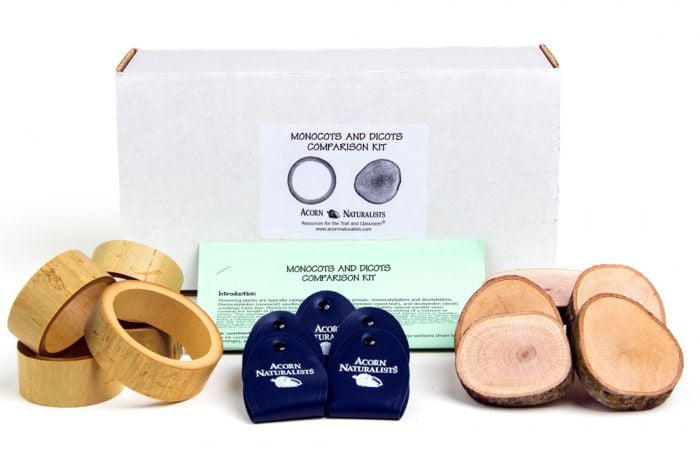Monocot and Dicot Comparison Discovery Kit®
Monocot and Dicot Comparison Discovery Kit®
Plants are divided by botanists into two groups: monocots and dicots. Monocots include grasses, lilies, orchids, and palms. Dicots include just about everything else! Monocots have sieve tubes in place of a cambium layer and lack growth rings. This unique kit explores these two groups through tree rounds. The kit includes five bamboo rounds, five oak rounds, five 3x magnifiers (for comparing dicot tree rings with monocot sieve tubes) and instructions. Recommended for ages 11 to adult.
#KIT-22149
Introduction (from the activity booklet that comes with this kit):
Flowering plants are typically categorized into two main groups: monocotyledons and dicotyledons. Monocotyledon (monocot) seedlings typically have one cotyledon (seed-leaf), and dicotyledon (dicot) seedlings have two. Monocot leaves have a parallel vein structure (tightly-spaced parallel veins running the length of the leaves), while dicot leaf veins are reticulated (consisting of a network of veins). The vascular tissues (cells that transport food and water) in monocot stems occur in bundles found scattered throughout the stem (in groupings of sieve tube cells). Vascular tissues in dicots grow from a cambium ring (growth cells under the bark that encircle the stem). With a hand lens, you can see the vascular bundles on the bamboo and the circular rings (produced by the cambium layer) on the oak tree cross-sections. Monocot flower petals occur in multiples of three (3, 6, 9) while dicot flower parts occur in multiples of 4 or 5. Monocots, like grass, have many small fibrous roots and no central stem. These roots are called adventitious. Dicots have a taproot—one long central root. Dicot trees are more likely to have bark than similar-sized monocots like giant bamboo. Kit contents: This kit contains five 3x hand lenses, five bamboo cross-sections, five oak cross-sections (from tree trimmings), and an activity guide.
Receive 10% off when ordering 10 or more of this item. Upon checkout, discounts for all items are added together and collectively subtracted from the total.


